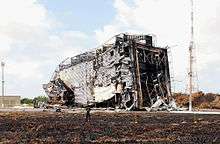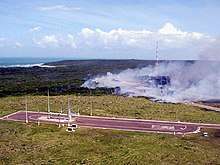VLS-1 V03
The 2003 Alcântara VLS accident was an accident during the Brazilian Space Agency's third attempt to launch the VLS-1 rocket, which was intended to have launched two satellites into orbit. The rocket exploded on its launch pad at the Alcântara Launch Center, killing 21 people.
 Wreck of the structure of the VLS launch pad | |
| Date | 22 August 2003 |
|---|---|
| Time | 13:26:05 BRT (UTC-3) |
| Location | Alcântara Launch Center, Maranhão, Brazil |
| Outcome | Setback to the Brazilian space program with the death of 21 technicians and destruction of launch vehicle and structure (launch pad and launch tower) |
| Deaths | 21 |
Background
This was the third attempt to launch the VLS-1 rocket. The first attempt, in 1997, ended in the Atlantic Ocean. In 1999, the rocket failed three minutes into the flight and was remotely terminated.[1]
The rocket cost $6.5 million.[2]
Payloads
The launch was suppose to carry the UNOSAT and SATEC in to orbit. Both were destroyed due to the explosion.[3][4]
Accident
On August 22, 2003, at 13:26:05 (local time) an inadvertent propellant ignition destroyed the launch vehicle as it stood on its launch pad at the Alcântara Launch Center in the state of Maranhão in northern Brazil.[5][5] Twenty-one people standing on the launch pad died when one of the rocket's four first stage motors ignited accidentally.[6] The explosion caused a fire in the nearby jungle brush, and produced a large cloud of smoke that was visible from far away.
Twenty-one people died in the explosion.[7] The number of casualties was initially unknown due to the catastrophic nature of the failure. The death toll was determined by holding a roll call.[8]
Aftermath

The explosion leveled the rocket's launch pad, reducing a 10-story high structure to a pile of twisted metal. The rocket had been scheduled to launch in just a few days and had two satellites on board when the explosion occurred. After the explosion, the Brazilian Space Agency was criticized for using solid-propellant rockets, which are easier to build and ignite than liquid-propellant rockets, but also lack throttle controls and emergency shut-offs.[9] The incident has caused a significant delay to the Brazilian space program because of government inquiries as well as the fact that many scientists and engineers who worked on the program were killed when the rocket exploded.[10]
An investigation by the Brazilian Government after the explosion found "dangerous buildups of volatile gases, deterioration of sensors and electromagnetic interference" at the launch site.[11]
References
- Cabrera, Adalid (23 August 2003). "Brazil Rocket Explodes on Pad". Arizona Republic. Phoenix, Arizona. Associated Press. p. A28 – via Newspapers.com.
- "Fatal blast hits Brazil space hopes". BBC. 23 August 2003. Retrieved 23 November 2019.
- "UNOSAT 1". space.skyrocket.de. Retrieved 4 June 2020.
- "SATEC". space.skyrocket.de. Retrieved 4 June 2020.
- "Análise Técnica do Relatório da Investigação do Acidente Ocorrido com o VLS-1 V03, em 22 de agosto de 2003, em Alcântara, Maranhão". 1 October 2013.
- "Space Today Online - Brazilian space rockets - a troubled road to space". www.spacetoday.org.
- "At Least 21 Killed, 20 Hurt in Brazil Rocket Explosion". News-Press. Fort Myers, Florida. Associated Press. 23 August 2003. p. 2A.
- Zimmermann, Patricia (22 August 2003). "Ignição de motor provocou explosão de foguete, diz ministro" [Engine ignition caused rocket explosion, says minister]. Folha de S. Paulo (in Portuguese). BBC. Retrieved 23 November 2019.
- "Ignition fault probed in Brazil blast". Flight Global.
- Plano Brazil. Retrieved on 2013-12-19.
- Space program management contributed to rocket explosion Red Orbit. Retrieved on 2012-03-06.